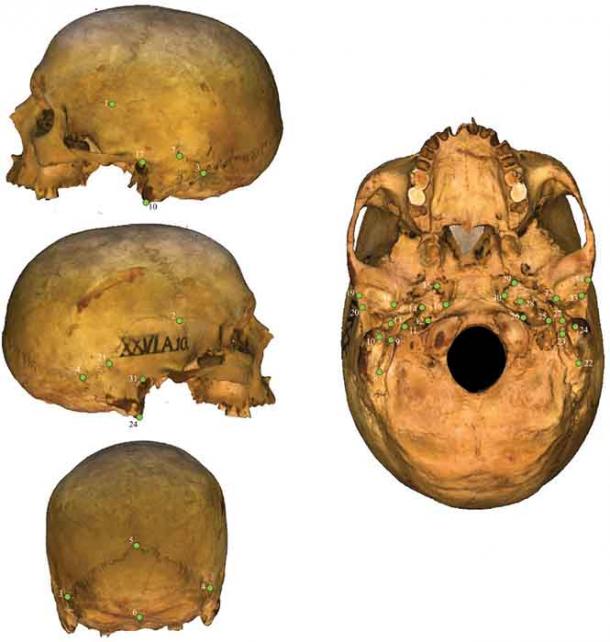The skull shapes of ancient Anglo-Saxons have revealed that they were bonded not so much by genetic heritage as their shared language and culture. What they farmed and how they fought is well understood, but what remained a mystery until this new study was: who were the Anglo-Saxons?
Studying the skeletal remains of Anglo-Saxons, particularly skull shapes, researchers have now revealed these legendary warriors were “a melting pot of people from both migrant and local cultural groups and not one homogenous group from Western Europe.”

Illustration of Anglo-Saxon society and clothing, 500-1000 AD. ( Public Domain )
Different Genetics, But the Same Songs, Stories and Dances
The team of archaeologists asked, and greatly answered, the long unanswered anthropological question: “ Who were the Anglo-Saxons ?” Published in the journal PLOS ONE , Professor Dobney at University of Sydney, Australia and Dr. Kimberly Plomp and Professor Mark Collard at Simon Fraser University in Vancouver, Canada, approached this tough question by analyzing three-dimensional renditions of the bases of Anglo-Saxon skulls.
The study mostly looked at remains from the early Medieval period in England, between the 5th-11th centuries AD, revealing “migration occurring throughout all but the final 100 years (ie. 410-560 AD),” according to the new study. Professor Keith Dobney said the team’s results indicate that the Anglo-Saxon kingdoms of early Medieval Britain were “strikingly similar to contemporary Britain – full of people of different ancestries sharing a common language and culture.”

Dr. Plomb capturing 3D photogrammetry of skull. (Kimberly Plomp / PLOS ONE )
Measuring Ancient Craniums
Back in the 19th century extrapolating information from a skull’s shape was an “art” called phrenology, which was finally discredited by scientists en mass in the 1840s. Phrenology is today regarded as a pseudoscience in which practitioners measure bumps and impressions on the skull to diagnose underlying health problems in the body’s organs . The art collapsed after the world’s Phrenologists repeatedly failed to agree on the most basic mental organ numbers – which ranged from 27 in some countries to over 40 in others.
Today, the scientific analysis of skulls is undertaken by palaeoanthropologists who can derive volumes of otherwise lost data from measuring the base of human skulls. In the new paper this measurement is described as a “shape signature that can be used to track relationships among human populations in a similar way to ancient DNA.”

Who were the Anglo-Saxons? Studying their skulls helped to solve that question. (Plomp, K.A, Dobney, K. & M. Collard/ PLOS ONE, 2021 )
Questing Cranial Clarity
The team collected 3D cranium data from remains excavated in both Britain and Denmark. With these they estimated the ancestry of the Anglo-Saxon individuals and found that between two-thirds and three-quarters of early Anglo-Saxon individuals were of continental European ancestry, while between a quarter and one-third were of local ancestry. Furthermore, the team also identified a change in the rate of migration and/or local adoption of culture over time.
This change in migration rate was revealed when they looked at skeletons dated to the Middle Anglo-Saxon period, which was several centuries after the original migrants arrived. It was found, according to Plomp, that “50 to 70 percent of the individuals were of local ancestry, while 30 to 50 percent were of continental European ancestry”. In conclusion, Professor Collard said these findings indicate that being Anglo-Saxon was more likely “a matter of language and culture, not genetics.”
Who were the Anglo Saxons? Drips of Peaceful Settlers or Barbaric Hordes?
The big question “ was”… did hordes of axe wielding European invaders quickly wipe out and replace the Romano-British inhabitants of England? Or did smaller waves of migrants slowly integrate, breed with, and settle with the local tribes, who quickly learned the language and cultural facets of the incoming Anglo-Saxon invaders?
Professor Dobney says this persistent point of confusion “is the apparent contradiction between early historical texts (written sometime after the events that imply that the newcomers were both numerous and replaced the Romano-British population) and some recent biomolecular markers directly recovered from Anglo-Saxon skeletons that appears to suggest numbers of immigrants were few”.
The researchers say their new data “sits at the interface of this debate.” Essentially, the new findings suggest early Anglo-Saxon settlements were “a mix of both newcomers and immigrants and, instead of wholesale population replacement, a process of acculturation resulted in Anglo-Saxon language and culture being adopted wholesale by the local population.”
Top image: Anglo-Saxon chieftain. Who were the Anglo-Saxons? Source: Archivist /Adobe Stock
By Ashley Cowie
 RSS Feed
RSS Feed















 June 27th, 2021
June 27th, 2021  Awake Goy
Awake Goy  Posted in
Posted in  Tags:
Tags: 













